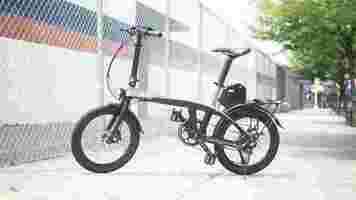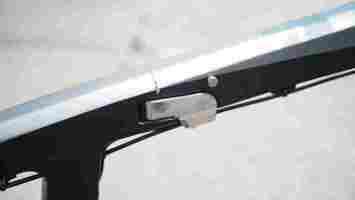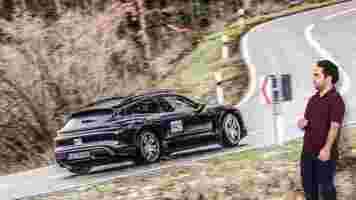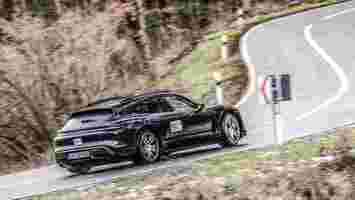These cute robots are now delivering pizza across Austin, Texas
This article was originally published by Sarah Wray on Cities Today , the leading news platform on urban mobility and innovation, reaching an international audience of city leaders. For the latest updates, follow Cities Today on Twitter , Facebook , LinkedIn , Instagram , and YouTube , or sign up for Cities Today News.

Start-up Refraction AI has launched a pilot program with ten of its REV-1 delivery robots in Austin, Texas.
The service launched with Southside Flying Pizza for deliveries in the South Congress, Downtown and Travis Heights areas of the city, with scope to expand as more businesses come on board.
The three-wheeled electric devices, which travel up to 15 mph and are controlled remotely, will operate in bike lanes or the street where bike lanes aren’t available. Assistants ride close by to ensure safety.
The delivery vehicles are described as “approximately the size of a person on a bicycle” at 1.37m tall (4.5 feet), 1.37m (4.5 feet) long and 76cm (30 inches) wide, and can hold around six grocery bags.
“Collaborating with innovators in this space gives us an opportunity to learn more about robotic delivery and how it can benefit the community as we continuously work to improve our transportation ecosystem,” said Gina Fiandaca, Austin Assistant City Manager for Mobility. “We believe that greater access to robotic last-mile delivery will lead to a greener future with safer, less congested streets, and we’re excited to leverage the technology as we continue to prioritize both sustainability and equity.”
No city funding is going into the pilot.
Safety
The operation of the vehicles in Austin is guided by state legislation , as well as resolutions passed by the City Council.
Jacob Culberson, Division Manager, Mobility Services, City of Austin, told Cities Today : “The city’s responsibility always is safety.”
The city worked with Refraction AI ahead of the launch, including ensuring the robots adhere to rules around lights, braking, etc. and demonstrating them for the fire and police departments.
Austin also sought feedback from the City of Ann Arbor, Michigan, where Refraction AI’s robots have been operating since December 2019 .
“Refraction AI was great in working with us to bring that together…and we feel confident that [the devices] are safe,” Culberson said.
One day at a time
Austin Transportation Department’s announcement of the robots on social media prompted a flurry of queries from local residents, including some concerns about the use of bike lanes.
“If we can reduce the number of single occupancy vehicles by supplanting them with small electric carriers that pose much less risk to people around them than traditional motor vehicles, then I think that’s a win,” Culberson said, adding that due to their size and speed: “I feel there’ll be little interference with our bicycle folks.”
The devices are required by state law to stop and yield the right of way to all other traffic, including bikes and pedestrians. According to Refraction AI, the REV-1 has “the shortest stopping distance of any device on the road”.
Culberson says the city will take things “one day at a time” and could develop local regulations if necessary, as it did with e-scooters.
There is no formal data-sharing requirement for the pilot but Refraction AI has agreed to share some data points with the city. Residents are also encouraged to report any issues to the 311 service.
“Over the past year, it has become more apparent that our current solutions for on-demand delivery are broken; local businesses and households are having a hard time keeping up with rising fees while profitability remains elusive for even the biggest players,” said Luke Schneider, CEO of Refraction AI, which launched in 2019. “Our expansion into Austin marks another step in our vision to transform last-mile delivery into a ubiquitous, accessible, sustainable service that anyone can take part in.”
Starship Technologies also ran a short pilot with sidewalk delivery robots in Austin in 2017.
Do EVs excite your electrons? Do ebikes get your wheels spinning? Do self-driving cars get you all charged up?
Then you need the weekly SHIFT newsletter in your life. Click here to sign up .
Furo X review: A carbon fiber folding ebike for weight weenies
Ebikes are inevitably heavier than their analog counterparts thanks to the addition of a motor and battery, so getting them to approximate the weight of typical ‘analog’ counterparts isn’t going to happen unless you make some unique changes to the frame. And nothing is more associated with reduced weight in the cycling world than good old carbon fiber.

That’s the approach FuroSystems’ Furo X takes as one of relatively few carbon fiber folding ebikes on the market. The ebike manages to weigh just 34 pounds fully loaded with battery, fenders, and a rack, which is positively featherweight by ebike standards. The only ebike I’ve tested that’s significantly lighter are the new LeMonds , and while I’ve tested a few other featherweight ebikes , it’s rare to find something under 40 lbs in the folding category.
That does come at a price though: the Furo X costs $2,299, or $2,599 for the larger battery variant I tested. There are also a few flaws that prevent it from being an unqualified recommendation. Still, for those looking for a compact and very ‘live-with-able’ ebike, the Furo X is worth a closer look.
What do I mean by ‘live-with-able,’ you ask? It’s about the subtler things you don’t see on a spec sheet. Is the bike going to be easy to carry into a subway? Is there an easy way to lock up the bike? Is the assistance smooth or jerky? The Furo performs well at most of these.
For the most part, the Furo X feels well thought out. The carbon fiber frame means it’s easy to carry up a set of stairs, and the folding mechanism obviously opens up a lot of storage possibilities — as well as the ability to call a cab if you get a flat.
Here are the specs you’re getting for your hard-earned money:
Bafang 250W rear hub motor (500W peak).
25 km/h (15.5 mph) speed limit, adjustable up to 40 km/h (25 mph) in the settings.
15kg/33lbs weight (tested at 34 lbs with the larger battery).
314/378 Wh battery options with Samsung cells.
Shimano Sora 9-seed derailleur.
A USB port on the battery.
Shimano Hydraulic disk brakes.
An adjustable stem to support riders from 5′ 2″ to 6′ 2″.
Turn signals
As of posting this article (and for the past several months), Furo has included the fenders, rear rack, kickstand, and front and rear lights with the bike, although these accessories are listed as a ‘limited offer.’


The bike has a few unique design quirks. For one, the removable battery is mounted on the exterior, behind the seatpost (there’s a neat little carrying handle). For another, the seatpost has a bit of a teardrop shape, which helps prevent the saddle from falling out of alignment (but means you can’t swap it with a suspension seatpost).
I dig the design, although I’d prefer more minimalist branding from Furo. Having ‘CARBON’ written in bold letters is quite unnecessary.
My impressions of the ride quality were positive. For one, the bike seemed to absorb bumps significantly better than I’m used to from folding bikes. Maybe it’s placebo, but I thought the carbon fiber frame was more forgiving of road imperfections and absorbed vibrations a little better than any folding bike I’ve tested without suspension.
The touchpoints are also solid, with a comfortable Selle Royale saddle (this is, of course, subjective), and grips with nice wrist support. The folding pedals are pretty much the same as you’d find on 90% of folding bikes — it would be nice to see larger, metal folding pedals for once — but they get the job done. The Shimano Sora derailleur is also a step up from the typical Tourney or Altus you’ll find on most ebikes, with reliable shifting.
You can also really see just how much the carbon fiber contributes to the low weight; when you pick up the bike, the weight is extremely biased towards the rear, while the front feels super light. It would be really easy to do a wheelie if I could do a wheelie.
The Bafang motor offers a good amount of power– torquey-er than you might expect for only 250W. I tend to gravitate towards ebikes that don’t have absurd amounts of power. The Furo X gets me up hills and helps me get started from a red light, and that’s all I personally really care about — I’m no speed demon. That said, although the speed limit is adjustable to the display’s settings, the motor isn’t going to offer much juice beyond 29 km/h (18 mph) or so.
It’s just a shame that a bike at this price point only offers a basic 12-magnet cadence sensor instead of a torque sensor . A cadence sensor only measures if and how fast you are pedaling, while a torque sensor measures how hard you are pedaling. The latter almost always feels more responsive, intuitive, and natural than a cadence sensor.
To be fair, the Furo X has one of the smoother cadence-based systems I’ve tried, but again, this is a $2,000+ bike we’re talking about. Though not everyone will notice the difference, the Furo X is the only ebike I’ve written about in this price range without a torque sensor.
My other big pet peeve: the lights on the Furo X are awful. Honestly, the worst I’ve seen out of a dozen or so ebikes tested recently.
It’s bad enough that the lights are not wired directly into the main battery, but that would’ve been okay if Furo had given you something better than average. Instead, the front light can only really illuminate a pitch-black road, and an optional flashing pattern can just barely help you be seen in the daylight. But the tail light which sits in the battery pack (and yet somehow requires charging via micro USB) is just sad.
The big chunk of red plastic would make you think that you’d get a nice bright light, but instead you get a measly single LED at the center. This tail light does feature turn signals which you operate via a remote (another thing to charge), and these light up slightly more noticeably, but the light is only really useful for visibility if you keep it in hazard mode (press left and right) permanently for visibility.
On a more positive note, range is surprisingly solid for just a 378 Wh battery. Although I didn’t get to fully drain the battery, I was able to travel about 12 miles in assist levels 4-5 while depleting roughly 40% of the battery. Considering I’m a heavier rider, that’s a good amount of range, no doubt aided by relatively low maximum speed. Furo’s claim of 60 kilometers (40 miles) for the larger battery pack seems realistic for the average rider.
The Furo X isn’t perfect, but it offers good ride quality and is one of very few folding bikes in this weight class. If you want to spend less money and don’t mind some extra heft, there are plenty of great affordable ebikes out there, but as a lightweight, fully equipped folding ebike, the Furo X is worth a look. Just get yourself some new lights.
Porsche’s Taycan Cross Turismo EV isn’t as confusing as it looks
German automaker Porsche is putting its Taycan Cross Turismo through its paces in final testing before it goes on sale next year. It sounds like everything is going well, but one thing is bothering me, well, it’s not one thing, it’s the entire thing.

The Porsche Taycan Cross Turismo seems more confused than a chameleon at a carnival.
First off, is its name. The Taycan part makes sense. It’s what Porsche called its high-performance EV, so that needs no explaining. This car is also an EV. I think you’re following.
The Cross Turismo bit, that’s more of a head-scratcher. It seems Porsche is designing this version of the Taycan for light off-roading and for those that want to travel further afield — that explains the Cross and Turismo part.
Ok, so that’s not totally insane. Especially considering the current Taycan is very much a performance oriented vehicle.
But then we get to how it looks. Seriously, just look at the thing.


Is it a fast-back, a station wagon, a shooting brake? I can’t quite put my finger on it, so let’s just say that it’s all three. According to Porsche though, it’s a CUV (cross utility vehicle). The company says it’s raised its suspension and even fitted it with a special driving mode for gravel, and so that qualifies it to be classed as some kind of crossover.
Whatever class of vehicle it’s in, it’s still kinda ugly. Despite Porsche being responsible for some of the world’s most iconic designs, the Taycan Cross Turismo doesn’t appear to be one of them… yet.
When the German automaker first brought out its Panamera , I had to carry a little bucket around with me just in case I saw one and had to throw up. Over time, it’s grown on me to the point I question my former self and consider the Panamera quite the looker.
I suspect the same will be of the Taycan Cross Turismo. Its bulky haunches, and squatted dog rear end, might be a little hard to stomach now, but in time, it’ll age well… hopefully.
Things start to make a lot more sense when we move from the exterior to the interior. Sadly, there don’t seem to be any proper interior images, but that’s beside the point. We can assume it’ll be exactly like the original Taycan when it comes to the interior hardware.
What matters about the interior is its space.
With the Taycan Cross Turismo, Porsche says it has developed an entirely new roofline, added roof rails, made the second row of seats more generous, and made the trunk bigger.
In other words, you can take your adult friends, on long distance road trips, and not have to sit with bags on your knees.
The original Taycan isn’t exactly a small car on the outside, but given its low slung roofline and saloon boot its interior dimensions can be a bit limiting. It seems the Cross Turismo is set to remedy that. Now it’s making sense.
The Taycan Cross Turismo, unlike its sibling, is not a hardcore performance focussed EV eager to be unleashed on the race track, it’s a car designed for actual humans that have friends and families, and might occasionally drive on roads that are a bit slippy.
I take it back, the Porsche Taycan Cross Turismo isn’t as confusing as it seems on first impressions. It makes perfect sense, so long as you can deal with how it looks.
SHIFT is brought to you by Polestar. It’s time to accelerate the shift to sustainable mobility. That is why Polestar combines electric driving with cutting-edge design and thrilling performance. Find out how .